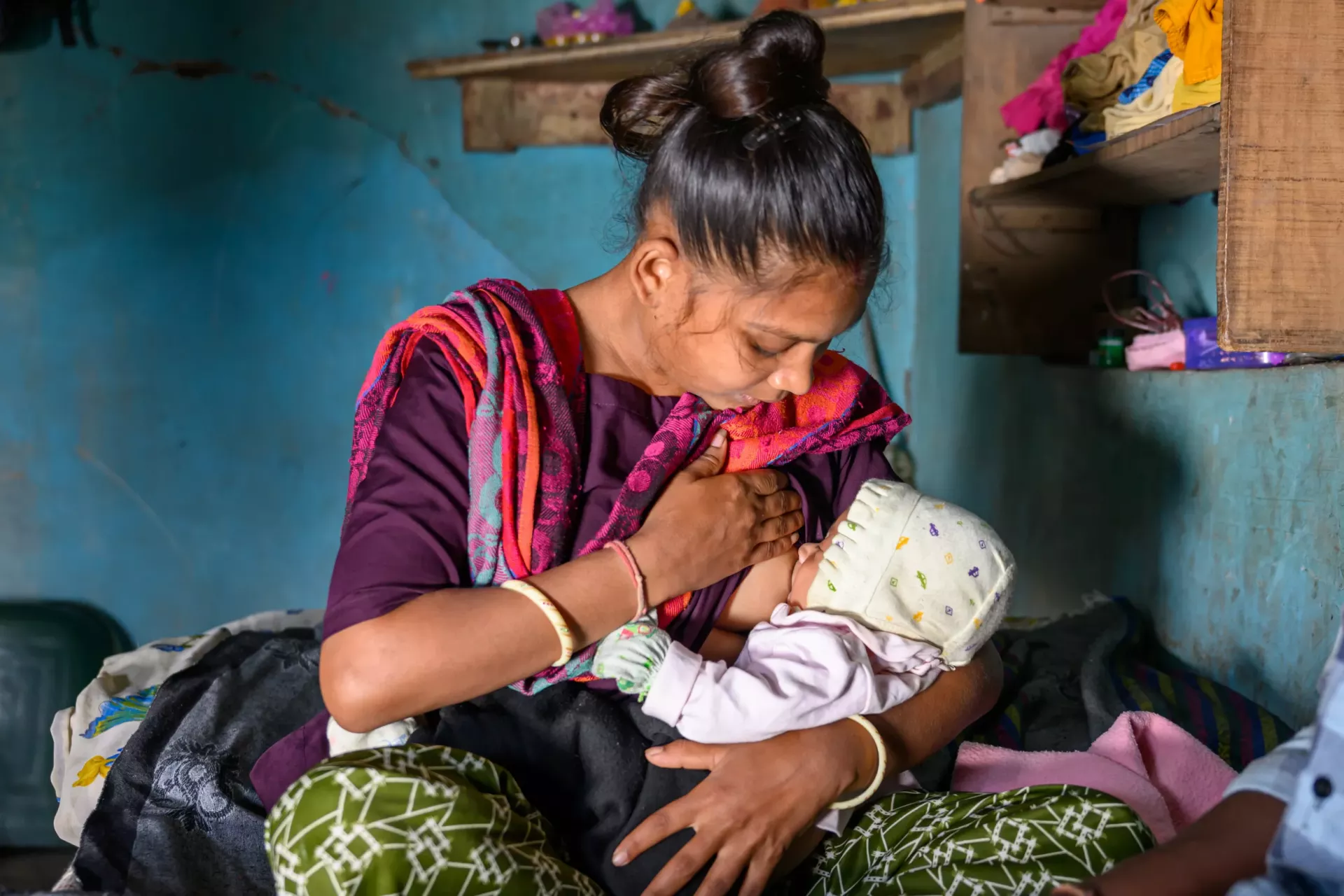With about 25 million babies born each year, India accounts for nearly one-fifth of the world’s annual child births. Around 4 out of 5 of these infants are breastfed at some point. Nearly 6 in 10 are fed nothing but breast milk for the first three months, while 4 in 10 remain exclusively breastfed for the full six months.
Six months of exclusive breastfeeding as recommended by the Ministry of Health and Family Welfare (MoHFW), through its Infant and Young Child Feeding (IYCF) guidelines, will cost a mother an average of 4–6 hours per day – the equivalent of a part-time job plus plenty of discomfort and lack of sleep. Yet unlike formula, breast milk production is not included in gross domestic product, our primary measure of ‘the economy.’
Counting What Matters
The absence of breastfeeding from GDP figures highlights a deeper flaw in how global economies measure value: entire systems of accounting are built to overlook the vast realm of unpaid labour, much of which is carried by women.
Economists have long known that what we choose to count shapes what we choose to value. Yet breastfeeding, one of the most vital forms of infant nutrition, remains invisible in the world’s ledgers. Nancy Folbre, an American feminist economist, and Julie P. Smith, an Australian health economist, have spent years exposing this blind spot.
Breast milk is food. It has measurable value, costs, and consequences. But because it is produced by women’s bodies and not sold on a market, it vanishes from GDP.
Their argument is simple: breast milk is food. It has measurable value, costs, and consequences. But because it is produced by women’s bodies and not sold on a market, it vanishes from GDP. Folbre’s work on the economics of care and Smith’s groundbreaking studies valuing breast milk in national food systems show that this is a structural refusal to see women’s labour as work. Leaving breastfeeding out of GDP makes it easier for governments to treat women’s unpaid labour as an infinite, costless resource. Their research has informed debates at the UN, WHO, and ILO.
In 1988, feminist scholar and former New Zealand Member of Parliament Marilyn Waring detonated a debate that still reverberates today in her landmark book If Women Counted. Her argument cut straight to the bone. By design, GDP inflates the value of market work while rendering invisible the vast economies of care that sustain it. A mother who stays home to raise her children contributes nothing to national accounts, but if she pays someone else to do the same job so she can join the formal workforce, GDP registers again. What looks like growth is often just a statistical sleight of hand, a distortion that privileges the marketplace while erasing the unpaid labour on which it rests.
Breastfeeding and the UN System of National Accounts
Under the UN System of National Accounts (SNA) as revised in 2008, the global gold standard for calculating GDP, anything a household produces and consumes, from rice grown in a backyard plot to water fetched from a well, sits within the production boundary. The United Nations Statistics Division (UNSD) has repeatedly clarified that breastfeeding fits within SNA rules: it is a form of non-market production of food and can be measured in monetary terms using market substitutes (like the price of formula).
When breast milk is rendered invisible in the national accounts, policies that could safeguard and support women’s ability to feed their children are treated as secondary, even optional. The result is a profound bias: governments underinvest in maternity protections, workplaces remain hostile to lactation, and formula marketing is allowed to fill the void. The economic stakes are not marginal. In 2022, researchers estimated that breastfeeding carried the potential to generate $574 billion in value worldwide, roughly 0.7% of global GDP, while saving families more than 10% of their household income by avoiding formula costs.
Measuring Milk: The Mother’s Milk Tool
Spurred by the fact that leading economists, including Nobel Prize winners Joseph Stiglitz and Amartya Sen, had argued that breast milk should be counted in GDP, with far-reaching consequences for how national output is measured and policies shaped, researchers at the Australian National University partnered with health professionals and Alive & Thrive Southeast Asia & Pacific. Together, they developed the Mother’s Milk Tool (MMT), a pioneering effort to assign a concrete economic value to women’s lactation.
The Mother’s Milk Tool (MMT) includes a built-in predictor that estimates monthly breastfeeding rates from birth to three years, using at least three data points, with accuracy improving as more data are fed in.
Earlier tools could only calculate the costs of not breastfeeding or the investment required to expand support for it. The Mother’s Milk Tool (MMT) goes further. It includes a built-in predictor that estimates monthly breastfeeding rates from birth to three years, using at least three data points, with accuracy improving as more data are fed in. Crucially, the MMT also attaches a market value to breastmilk itself: pegged at 100 USD per litre, based on the going rate in Norway’s human milk banks. The tool can then convert this value into local currencies, effectively transforming an invisible form of production into a measurable — and comparable — economic asset.
The Global Human Milk Economy
Human milk has already entered global trade. In 2017, Australia authorised Neolacta to import breast milk from Indian mothers for hospitals. In the US, Ambrosia Milk began buying Cambodian mothers’ milk in 2015, paying small sums that improved living standards and allowed more time with infants. Prolacta, the largest player, buys milk at around $30 per litre and sells it to US hospitals for nearly $300. Commercial wet-nursing and milk exchanges have also resurfaced in China and North America.
Selling or donating surplus milk has the potential to transform child nutrition and provide financial and health benefits for mothers. Parents are willing to pay for better nutrition and well-being. Yet economists debate whether milk markets respond to the usual rules of supply and demand, whether breastfeeding meets the test of “economic sensitivity.” Even so, across centuries and cultures, breastfeeding remains the first and essential food for infants, sustaining what might be called the global “infant and young child (IYC) food economy.”
The Case for Inclusion
Women’s productivity in lactation is undermined by competition from low-cost dairy, commercial breastmilk substitutes, and labour market pressures. Norway remains the only country to include breast milk production in national food statistics, a practice the UN Food and Agriculture Organisation has not standardised. Comparable estimates exist for Australia, the US, and select other countries.
Under national accounting frameworks, all non-market production — from homegrown fruit to processed household food- counts toward GDP. Breast milk fits these criteria: it is produced, stored, and can be sold or traded, giving it a measurable economic value. Milk banks in North America sell human milk for $85–150 per litre; in Norway, it trades for around $100; in the UK, £100–200 per litre.
Recognising breast milk in national accounts could challenge entrenched gender biases, prompting governments to prioritise women’s economic well-being, support breastfeeding, and ensure infant health. Combined with tools like the Mother’s Milk Tool, such recognition transforms breastfeeding from invisible labour into a counted, valued, and policy-relevant economic contribution.
Sellers offering human milk on internet milk trading sites such as Only the Breast typically ask around US$3 per ounce ($100 a litre) if they have health certification (Only The Breast 2013). In Cambodia in late 2015, mothers were reportedly being paid $0.5-1.0 an ounce (around $15-30 a litre) for milk that was to be sold in the United States for around $3-5 per ounce (around $100-150 a litre). In October 2016, the China Daily reported that unpasteurized, freshly frozen milk is sold in around 100 stores in China at around $22-75 per litre, with prices ranging up to $150 a litre.
Breastmilk as a carbon-offset commodity
Carbon or greenhouse gas accounting measures and analyses the carbon dioxide emissions of individuals, organisations, or nations, forming the basis for carbon markets. Central to these schemes is the concept of carbon pricing, where emitters pay for the cost of offsetting their greenhouse gas emissions through the purchase of carbon credits. A prominent example is the United Nations Carbon Offset Platform, which allows buyers to fund projects in low- and middle-income countries via Certified Emission Reductions.
Increasing the visibility of women’s lactation work in key economic statistics might challenge the gender bias in policy, which under-prioritises allocating resources to address the economic well-being of women and children.
Parallel to this, tools like the Mother’s Milk Tool (MMT) quantify breastmilk production and its economic value, using UNICEF data on infant and young child feeding practices and assigning a proxy value of USD 100 per litre, based on rates in Norway’s human milk banks. Complementing this, the Cost of Not Breastfeeding Tool calculates the health system costs and lost economic opportunities when breastfeeding is displaced by commercial formula, while the Green Feeding Tool assesses the greenhouse gas emissions and water use associated with formula production and consumption in low- and middle-income countries. The Green Feeding Tool can also estimate the carbon offsets of programs and policies designed to increase breastfeeding rates, linking infant nutrition to climate-conscious interventions.
Increasing the visibility of women’s lactation work in key economic statistics might challenge the gender bias in policy, which under-prioritises allocating resources to address the economic well-being of women and children. Properly valuing crucial care and environmental resources in our economic measurement systems would redirect international financial resources away from expanding potentially harmful economic activity and towards what really matters, including health for all. Doing so starts with recognising and accounting for breastfeeding as the local, sustainable and healthy first-food system in economic and climate frameworks. It is a crucial investment in the health, equity, and resilience of generations to come.
About the author(s)
Vanita is a lawyer by training and writes stories at the intersection of business & public policy, law, regulations and building inclusive workplaces. She is a Staff Writer for The Ken.




